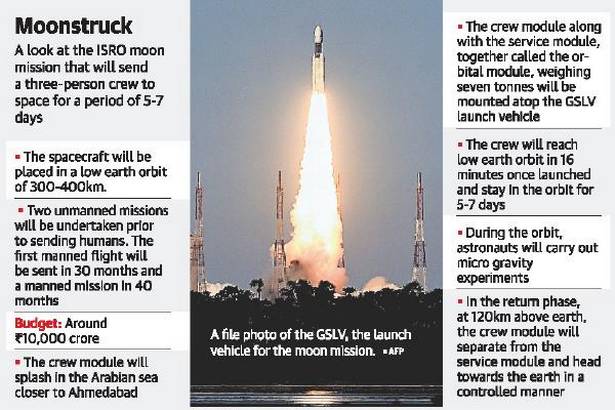

The spacecraft, which is being developed by the Indian Space Research Organisation (Isro), consists of a service module and a crew module, collectively known as the Orbital Module.
It will be for the first time that India will launch its manned mission to space, making the country fourth in line to have sent a human to space.
Isro's Geosynchronous Satellite Launch Vehicle GSLV Mk III, the three-stage heavy-lift launch vehicle, will be used to launch Gaganyaan as it has the necessary payload capability.
GSLV Mk III is designed to carry 4 ton class of satellites into Geosynchronous Transfer Orbit (GTO) or about 10 tons to Low Earth Orbit (LEO). The powerful cryogenic stage of GSLV Mk III enables it to place heavy payloads into LEO's of 600 km altitude.
The launcher uses two S200 solid rocket boosters to provide the huge amount of thrust required for lift off.
10 things you must know about India's ambitious mission
1)The crew module, in which the three astronauts will leave for space, will be made of 3.7-metre diameter and seven-metre height.
2)According
to G Madhavan Nair, former Isro chief: The mission will enable ISRO to
achieve higher levels of reliability in launch and satellite technology.
It will help in providing employment to 15,000 people and out of them,
861 will be from Isro.
3)The human spaceflight will take 16 minutes to reach the orbit where it will stay for five to seven days.
4)The spacecraft will be placed in a low earth orbit of 300-400 km.
5)The
Indian space agency displayed the Gaganyaan crew model and orange space
suits at the Bengaluru Space Expo's 6th edition earlier this year. The
space suit were developed at Vikram Sarabhai Space Centre,
Thiruvananthapuram.
6)With the ability to hold one oxygen cylinder, the suit will allow the astronaut to breathe in space for 60 minutes.
7)The
capsule will rotate around the Earth every 90 minutes, and astronauts
will be able to witness sunrise and sunset. The three astronauts will be
able to see India from space every 24 hours, while they conduct
experiments on micro-gravity.
8)For its return, the capsule will take 36 hours, and will land in the Arabian Sea, just off the coast of Gujarat.
9)Rs.
10,000-crore mission will be a turning point in India's space journey.
Isro has developed some critical technologies like re-entry mission
capability, crew escape system, crew module configuration, thermal
protection system, deceleration and flotation system, sub-systems of
life support system required for Mission Gaganyaan.
10)Isro
will receive assistance from the French space agency CNES, in terms of
expertise various fields including space medicine, astronaut health
monitoring, radiation protection and life support.
No comments:
Post a Comment